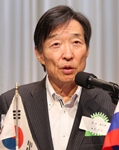��Quantitative and Qualitative Monetary Easing�� and the Financial and Economic Conditions of Japan
June 4, 2014
Mr. Kikuo Iwata
Deputy Governor, Bank of Japan
�� The Bank of Japan introduced the ��quantitative and qualitative monetary easing (QQE)�� policy in April 2013. Let me explain today its content, current situation as well as how it works to invigorate the Japanese economy and overcome deflation.
The Bank of Japan introduced the ��quantitative and qualitative monetary easing (QQE)�� policy in April 2013. Let me explain today its content, current situation as well as how it works to invigorate the Japanese economy and overcome deflation.
��The primary objective of this policy is to achieve the ��price stability target�� of a 2% increase in the consumer price index (CPI) on a year-on-year basis at the earliest possible time, with a time horizon of about two years.
��Deflation, which is a persistent decline in prices, causes economic stagnation through several routes. If people forecast that prices will decline persistently, the value of cash and deposits will rise simply by hoarding them. Thus companies and households will defer their investment and spending that will consequently lead to decline in aggregate demand. Corporate profits will deteriorate and employees�� income will fall accordingly. Those who borrow money will suffer from an increase in the effective burden of debt. Companies and households will become even more cautious about consumption and investment that will further shrink aggregate demand.
��Long-term forecasts of drop in prices will also lead to a rise in the yen��s value against foreign currencies. Hence, appreciation of the yen will prevail and give negative impacts on the export sector. Excessive appreciation of the yen will raise the cost of labor in Japan and encourage Japanese companies to transfer their production sites overseas, thus will hollow out our industrial base.
��The Bank of Japan has adopted the inflation targeting policy as a measure to overcome deflation. Similar policy was first adopted in New Zealand, Australia, the UK, Canada and Sweden in the late 1990s, followed by Thailand, South Korea, and Latin American countries after the Asian Financial Crisis. Euro-zone countries and the US are also targeting at around 2% inflation.
��Stable and moderate inflation will stimulate households to spend and shift their portfolios from cash and deposits to equities or foreign currency-denominated assets with higher returns. Companies will become more aggressive in their business fixed investment, leading to a virtuous cycle of economic recovery with a steady increase in aggregate demand, rises in prices, corporate profits and employees�� income.
��An inflation targeting policy has a number of advantages. As the policy contains a specific numerical target, it enhances the market predictability and facilitates various economic entities to forecast on price levels, exchange rates or share prices to base their spending, investment and saving plans on. In addition, a specific target will enhance credibility in monetary policy and make the Bank of Japan committed to preventing hyperinflation and stabilizing price levels, as seen in some countries that have already adopted the inflation targeting policy.
��The Bank of Japan has been pursuing the QQE policy that consists of two pillars: first is the commitment to achieve the 2% inflation target as soon as possible, and the second is to take specific actions in implementing the QQE policy. An increase in ��quantity�� means increasing the monetary base at an annual pace of about 60-70 trillion yen, mainly by massively purchasing long-term government bonds. A change in ��quality�� of the Bank��s asset mix refers to purchasing bonds with longer remaining maturities, on average about 7 years, that tend to have a higher risk profile.
��The most important factor to reflect the QQE results in the real economy is whether we manage to lower the ��expected real interest rates.�� Expected real interest rates are obtained by subtracting the ��expected rates of inflation�� from the nominal interest rates actually observed in financial markets or over the counter. The combination of raising inflation expectations, through the two pillars I have just explained, and restraining the rise in nominal interest rates will provide downward pressure on expected real interest rates. This will lower companies�� and households�� real costs of borrowing and eventually stimulate demand in the real economy.
��Since the implementation of the QQE policy in April 2013, share prices have risen and the yen is depreciating against the dollar. Expectations on increased aggregate demand have stimulated private non-residential investment to show positive growth. The CPI excluding perishables has turned from negative growth before the introduction of QQE to plus 1.5% growth this April.
��Positive signs are also observed in the labor market. Effective opening-to-application ratio rose to 1.08 times this April while the unemployment rate has come down to 3.6%. The real GDP growth rate also continues to register positive growth since the first quarter of 2013.
��Before closing, let me share with you the outlook on GDP and CPI discussed by the Policy Board of the Bank of Japan. The real GDP growth in fiscal 2014 is estimated to increase 1.1% from the previous year, followed by an increase of 1.5% in fiscal 2015. CPI is estimated to rise steadily by 1.9% in fiscal 2015 and 2.1% in fiscal 2016. We expect to achieve the target of 2% increase sometime between the end of 2014 to mid-2015